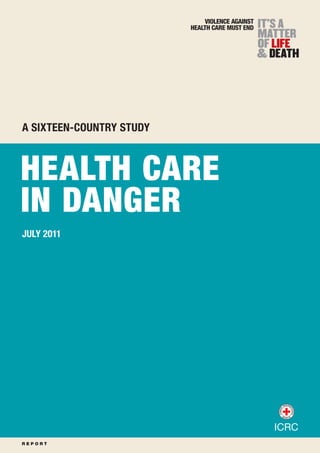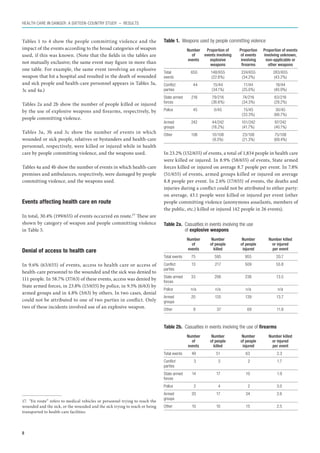This study analyzes 655 reported violent incidents affecting health care in 16 countries over 2.5 years. State armed forces were responsible for 33% of incidents and armed groups for 37%. Explosive weapons often damaged health facilities and injured people. Various types of health care providers were affected, including international NGOs (35%), local services (26%), and Red Cross organizations (17%). A total of 1,834 people were killed or injured, including 20% who were already wounded or sick and 9% who were health care workers. Hospitals were damaged in 18% of incidents and ambulances in 5% of incidents. The study aims to better understand violence against health care in these conflict-affected countries in order to identify measures




![Health care in danger: A sixteen-country study – Introduction
of violence, many thousands of wounded and sick people all over from the armed conflict.5 Polio eradication in Afghanistan and
the world do not get the health care to which they have a right. Pakistan is hampered by insecurity and so hundreds of thou-
sands of children cannot be vaccinated against polio.6 The United
Violence against health care, both actual and threatened, is often Nations Secretary-General, the United Nations Development
an immediate consequence of armed conflict and other forms Programme and Human Security Report 2009-2010 make it clear
of violence that fall short of armed conflict, such as widespread that achieving the Millennium Development Goals pertaining
rioting or demonstrations. A single act of violence that damages to child health, maternal health and HIV/AIDS may well be
a hospital or kills health-care personnel has a knock-on effect on unachievable by 2015 because of the insecurity that follows in the
many other people requiring care, and especially the wounded wake of armed conflict.7 The Iraqi Ministry of Health has reported
and the sick, who suffer even more through lack of treatment. For that 628 health-care professionals have been killed since the 2003
example, an independent ICRC surgical hospital would normally US invasion and that 18,000 of 34,000 doctors have fled, with a
treat approximately two thousand wounded people per year.3 One catastrophic impact on Iraq’s health-care system.8
serious security incident can close such a hospital, drastically
reducing if not eliminating surgical services for the wounded. The countries that have suffered sustained periods of con-
This is precisely what happened when six ICRC nurses were killed f lict have the lowest numbers of health-care personnel. Per
by unidentified gunmen in the ICRC hospital in Novi Atagi, 10,000 inhabitants, the five permanent members of the UN
Chechnya, on 17 December 1996. The tragedy extended beyond Security Council have on average 28.4 doctors and 56 nurses,
the needless death of those Red Cross health-care workers to the whilst in comparison Afghanistan has 2 doctors and 5 nurses,
thousands of wounded people who, as a result of that incident, lost the Democratic Republic of the Congo has 1 doctor and 5 nurses,
access to essential surgical services. In the same way, catastrophic Somalia has 0.5 doctors and 1 nurse, and Iraq has 5 doctors and
damage was inflicted on Somalia’s already weak health-care infra-
structure when a bomb killed more than twenty people, including
two doctors and an unverified number of medical students, at
a graduation ceremony in Mogadishu in December 2009.4 If a
doctor in Somalia gives 250 consultations in a week, and assuming 5. B. Coghlan, R. Brennan, P. Ngoy, D. Dofara, B. Otto, M. Clements, T.
Stewart, “Mortality in the Democratic Republic of Congo: A nationwide
that 15 medical students or doctors were killed, their deaths rep- survey,” Lancet, 2006, Vol. 367, pp. 44-51.
resent more than 150,000 consultations per year that will not take 6. See e.g. the Global Polio Eradication Initiative Strategic Plan 2010-
place as a result of that single attack. On a less dramatic note, in 2012, p. 17, and in relation to the border area between Pakistan and
some situations ICRC field teams have reported that hospital staff Afghanistan, see pp. 17, 21 and 51. Available at: http://www.polioeradi-
cation.org/ResourceLibrary/StrategyAndWork/StrategicPlan.aspx. See
in areas prone to conflict are most concerned, in terms of their also independent evaluations of polio eradication commissioned by the
own safety, about direct threats from relatives of the wounded WHO. The Report on the Independent Evaluation of the Major Barriers
and the sick; these threats are triggered by dissatisfaction with the to Interrupting Poliovirus Transmission in Afghanistan: Final Report
October 2009 by Michael Toole, Stephanie Simmonds, Benjamin Coghlan
available health-care services. and Najibullah Mojadidi states on p. 5 that: “Insecurity poses the most
significant non-health sector barrier to achieving high polio vaccination
Beyond individual acts of violence that have a massive impact coverage throughout the country. The security situation is unstable, unpre-
dictable, and threatened by a range of armed factions.” See also Assad
upon care for the wounded and the sick, there are also whole
Hafeez, Corinne Shefner-Rogers, Philippe Borel, Rakhshinda Perveen and
areas of many countries in which it is simply too dangerous for Viroj Tangcharoensathien, Independent Evaluation of Major Barriers to
health-care personnel to move around or work. The total impact Interrupting Poliovirus Transmission in Pakistan, p. 5: “Security hampered
of general insecurity on health care is difficult to assess, and there access to immunization in several districts of NWFP/FATA [North-West
Frontier Province/Federally Administrated Tribal Areas] and Balochistan,
is consequently limited evidence of it in the public domain. There making it difficult to reach large numbers of children.”
are, however, some indicators of the huge importance of this issue. 7. See “Keeping the promise: A forward-looking review to promote an
The impact of general insecurity in one country alone is dem- agreed action agenda to achieve the Millennium Development Goals by
onstrated by a study in the Democratic Republic of the Congo, 2015: Report of the Secretary-General,” United Nations General Assembly,
February 2010: pp. 3 and 11. See also What Will it Take to Achieve the
in which it is estimated that 40,000 deaths per month are due Millennium Development Goals? – An International Assessment, United
to diseases that are easily treatable; the stated reason for these Nations Development Programme, June 2010, pp. 19-20, available at: http://
people not receiving the necessary treatment is insecurity arising content.undp.org/go/cms-service/stream/asset/;jsessionid=aMgXw9lbM
bH4?asset_id=2620072; Beyond the Midpoint: Achieving the Millennium
Development Goals, United Nations Development Programme, January
2010, pp. 60-75, available at: http://content.undp.org/go/cms-service/stream/
asset/?asset_id=2223855; and Human Security Report 2009-2010, Chapter 5,
3. An ICRC hospital is set up only when no other surgical care for the “Deadly connections: Wartime violence and indirect deaths,” and Chapter 7,
wounded is available. “The death toll in the Democratic Republic of the Congo.”
4. Figures for the impact of this event vary between reports. Up to 24 people 8. J. Zaracostas,. “Exodus of medical staff strains Iraq’s health facilities,”
may have died, including four ministers, three journalists and the dean of British Medical Journal, 28 April 2007, Vol. 334, p. 865. See also “Rising to
the medical school. See AFP, “Mogadishu suicide attack was Somalia’s 9/11,” the humanitarian challenge in Iraq,” Briefing Paper, Oxfam International,
NGO-Times LIVE, 8 December 2009, 7.20 p.m., by Sapa-AFP. July 2007, p. 11.
3](https://image.slidesharecdn.com/03-120527090858-phpapp01/85/Sixteen-Country-Study-Health-Care-in-Danger-5-320.jpg)









![Health care in danger: A sixteen-country study – Annex 1
Annex 1
The model used by Insecurity Insight19 for this study (the “Taback - Two masked men [number of people armed] entered Hospital X [where]
Coupland model”) begins with a theory that states that an act of violence last night [when] and shot [weapon (firearms)] dead [outcome] a [outcome]
must take place at a given time and place and that the outcome of any act of sleeping patient [vulnerability]. (Shot dead = intent)
violence has four determinants. These determinants are:
the nature of the weapon; The method uses written reports of real incidents of armed violence as the
the number of weapons in use or number of users armed; source for the necessary values. Information from a report on an individual
how the weapon is used (the psychological aspect of the violence, e.g. incident is entered into a spreadsheet specially designed to capture and
intent, strategy or motivation); process information about the people committing violence and about the
the vulnerability of the potential victim. victim(s) or potential victim(s). In this way, reports of violence in a given
context or affecting a particular vulnerable group are translated into a
The interaction of the people committing violence and the outcome for the database. Qualitative data is translated into quantitative data.
victim(s) can be described in those terms.
By analysing the data generated by this method, the nature and outcome
Importantly: of violence in a given context can be described in quantitative terms. This
each determinant is necessary but not sufficient by itself to cause the indicates threats (the determinants on the side of the people committing
effect in question; violence) and victims’ vulnerabilities. The identification of threats and vul-
any preventive measure falls within one or more of these determinants. nerabilities then indicates entry points for preventive policies.
An example is the lethality of attacks with firearms. This will be determined The kind of data that can be generated and the conclusions that can be
by: drawn depend entirely on the completeness and accuracy of the reports
the kind of firearms (death is more likely if a larger calibre weapon is used.
used, because the wound will be bigger);
how many firearms are being shot against the victim(s);
whether the user is standing close to (e.g. 5 metres) or further away (e.g. Annex 2
200 metres) from the victim(s); Media search terms
whether the victim(s) of the attack are cornered, tied up, can run away or (Red Cross or red crescent or UNHCR or UNICEF or World health or WFP
take cover. or UNDP or MSF or Oxfam or handicap international or german agroaction
or save the children or mdm or medecins du monde or humanitarian aid or
This example also shows the important interaction at a psychological level NGO* or aid worker* or ambulance or Hospital* or doctor*) and (attack* or
between how the weapon is used, the other determinants and perceptions of threat* or kidnap* or hostage* or arrest* or assassinate* or dead or death* or
the potential outcome. (Whether the trigger is pulled to cause a fatal injury kill* or murder* or massacre* or wound* or injure* or torture* or hurt* or
is influenced, for example, by whether the user of the firearm believes he or survive* or uninjured).
she can hit the victim(s) with it, whether there are others similarly armed,
how easy it is to hit the victim(s) in that context, and whether the victim(s) Applied to countries in question.
have already been hit.)
This theory applies to any act of violence using any weapon causing any
effect in any context.
The theory becomes a statistical model when numeric values are given for
who did what, to whom, where, when and by what means (including the
kind of weapon), using reports of real incidents of violence.
A “report” can be a very short text as indicated by the following sentence:
“Two masked men entered Hospital X last night and shot dead a sleeping
patient.”
19. The method was developed by Insecurity Insight (www.insecurity-
insight.org). It has been used successfully to study attacks on journalists
in conflict, sexual violence in the Democratic Republic of the Congo and
explosive violence, and to map violence in eight different countries.
13](https://image.slidesharecdn.com/03-120527090858-phpapp01/85/Sixteen-Country-Study-Health-Care-in-Danger-15-320.jpg)



